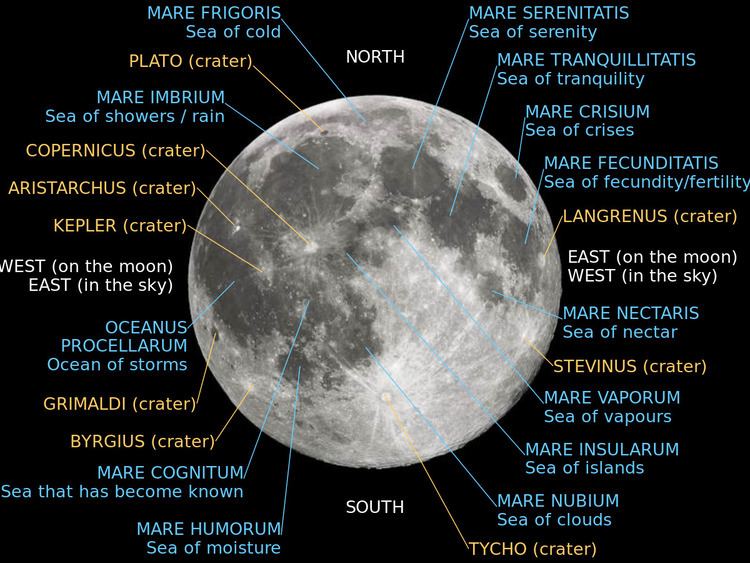 | ||
Several features cover the surface of the Moon. These are listed below.
Contents
Valleys
Among many lunar features are several large valleys that have been given names. Most of these valleys are named after a nearby crater; see the list of craters on the Moon for more information.
Water features
This is a list of maria (singular mare) on the Moon. Lunar Maria are the large, dark, regions of the moon. They do not actually contain any water, however they are believed to have been formed from molten rock from the moon's mantle coming out onto the surface of the moon. It also includes the one oceanus and the features known by the names lacus, palus and sinus. The modern system of lunar nomenclature was introduced in 1651 by Riccioli. Riccioli's map of the moon was drawn by Francesco Maria Grimaldi, who has a crater named after him.
Maria and Oceanus
There was also a region on the Lunar farside that was briefly misidentified as a mare and named Mare Desiderii (Sea of Dreams). It is no longer recognized. Other former maria include:
Lacus
A related set of features are the Lunar lacus (singular lacus, Latin for "lake"), which are smaller basaltic plains of similar origin:
Sinus and Paludes
A related set of features are the sinus (singular sinus, Latin for "bay") and paludes (singular palus, Latin for "marsh"):
Some sources also list a Palus Nebularum ("Marsh of Mists") at 38.0° N, 1.0° E. However the designation for this feature has not been officially recognized by the IAU.
Mountains
These are isolated mountains or massifs.
Note that the heights listed below are not consistent across sources. In the 1960s, the US Army Mapping Service used elevation relative to 1,737,988 meters from the center of the Moon. In the 1970s, the US Defense Mapping Agency used 1,730,000 meters. The Clementine topographic data published in the 1990s uses 1,737,400 meters.
Also note that this table is not comprehensive, and does not list the highest places on the Moon. Clementine data show a range of about 18,100 meters from lowest to highest point on the Moon. The highest point, located on the far side of the Moon, is approximately 6500 meters higher than Mons Huygens (usually listed as the tallest mountain).
Other features
The Moon's surface is covered in many interesting geological features. In addition to mountains, valleys, and craters, the following surface features have received names in the Lunar nomenclature. Many of these features are named after a nearby crater or mountain.
The listed diameter for these features is the longest dimension that contains the entire geological formation. The latitude and longitude are in selenographic coordinates.
Albedo
These features are notable for their high albedo compared to the surrounding terrain.
Note: On the far side of the Moon there are unnamed albedo features on Mare Ingenii and Mare Marginis. These are located antipodal to the Mare Imbrium and Mare Orientale impact basins.
Catena
A catena is a chain of craters.
Dorsa
These features are wrinkle-ridge systems commonly found on lunar maria.
Dorsum
These features are wrinkle ridges commonly found on lunar mare
Promontorium
These features form a cape or headland on a mare.
Rima
These features are lunar rilles.
Rimae
These features are lunar rille systems.
Rupis
These are escarpments in the surface.
Terra
The continental areas between the seas were given comparable names by Giovanni Battista Riccioli, but were opposite the names used for the seas. Thus there were the lands of sterility (Terra Sterilitatis), heat (Terra Caloris), and liveliness (Terra Vitae). However these names for the highland regions are no longer used on recent maps, and Terrae are not officially recognized as standard lunar nomenclature by the International Astronomical Union.
Craters
The large majority of these features are impact craters. The crater nomenclature is governed by the International Astronomical Union, and this listing only includes features that are officially recognized by that scientific society.
The lunar craters are listed in the following subsections. Where a formation has associated satellite craters, these are detailed on the main crater description pages.
